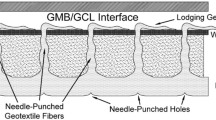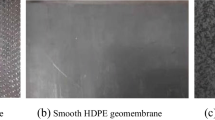Abstract
Because the normal stress applied to landfill liner systems increases with the volume of waste during the construction of engineered landfills, traditional shear tests do not adequately describe the loading process on the liner system because only one shear test is performed on a single sample. In this study, a series of laboratory tests using a new test method that differs from traditional shear tests were performed to investigate the repeated shear behaviors of geotextile/geomembrane (GT/GM) and geomembrane/clay (GM/clay) interfaces under various normal stresses. The test results indicated that increasing shearing times decrease the peak and residual shear strengths of both GT/GM and GM/clay interfaces. Additionally, the strength parameters obtained from traditional and repeated shear tests were both used to analyze global stability along the liner system of a typical landfill. The results of repeated shear tests and limit equilibrium analysis were determined to be significant for landfill liner system anti-slide design. The limitations of the tests were also discussed.















Similar content being viewed by others
Abbreviations
- FS:
-
Factor of safety
- GM:
-
Geomembrane
- GT:
-
Geotextile
- HDPE:
-
High density polyethylene
- LE:
-
Limit equilibrium
- MSW:
-
Municipal solid waste
References
Amaya P, Queen B, Stark TD, Choi H (2006) Case history of liner veneer instability. Geosynth Int 13(1):36–46
ASTM D2487–11 (2011) Standard Practice for Classification of Soils for Engineering Purposes (Unified Soil Classification System). ASTM International, West Conshohocken
Basudhar PK (2010) Modeling of soil-woven geotextile interface behavior from direct shear test results. Geotext Geomembr 28(4):403–408
Bergado DT, Ramana GV, Sia HI (2006) Evaluation of interface shear strength of composite liner system and stability analysis for a landfill lining system in Thailand. Geotext Geomembr 24(6):371–393
Briançon L, Girard H, Poulain D (2002) Slope stability of lining systems-experimental modeling of friction at geosynthetic interfaces. Geotext Geomembr 20(3):147–172
DeJong JT, Westgate ZJ (2005) Role of overconsolidation on sand-geomembrane interface response and material damage evolution. Geotext Geomembr 23(6):486–512
Eid HT (2011) Shear strength of geosynthetic composite systems for design of landfill liner and cover slopes. Geotext Geomembr 29(3):335–344
Esterhuizen JJ, Filz GM, Duncan JM (2001) Constitutive behavior of geosynthetic interfaces. J Geotech Geoenviron Eng 127(10):834–840
Filz GM, Esterhuizen JJ, Duncan JM (2001) Progressive failure of lined waste impoundments. J Geotech Geoenviron Eng 127(10):841–848
Fishman KL, Pal S (1994) Further study of geomembrane/cohesive soil interface shear behavior. Geotext Geomembr 13(9):571–590
Fleming IR, Sharma JS, Jogi MB (2006) Shear strength of geomembrane–soil interface under unsaturated conditions. Geotext Geomembr 24(5):274–284
Gilbert RB, Bryne RJ (1996) Strain-softening behavior of waste containment system interfaces. Geosynth Int 3(2):181–203
Hebeler GL, Frost JD, Myers AT (2005) Quantifying hook and loop interaction in textured geomembrane–geotextile systems. Geotext Geomembr 23(1):77–105
Hillman RP, Stark TD (2001) Shear strength characteristics of PVC geomembrane–geosynthetic interfaces. Geosynth Int 8(2):135–162
Jones DRV, Dixon N (1998) Shear strength properties of geomembrane/geotextile interfaces. Geotext Geomembr 16(1):45–71
Jones DRV, Dixon N (2005) Landfill lining stability and integrity: the role of waste settlement. Geotext Geomembr 23(1):27–53
Jones DRV, Taylor DP, Dixon NEIL (1997) Shear strength of waste and its use in landfill stability analysis. Proceedings Geoenvironmental Engineering. University of Wales, Cardiff, pp 343–350
Kavazanjian E, Matasovic N, Bonaparte R, Schmertmann GR (1995) Evaluation of MSW properties for seismic analysis. In: Proceedings of specialty conference, geoenvironment 2000: characterization, containment, remediation, and performance in environmental geotechnics, vol 2. ASCE Geotechnical Special Publication no. 46, pp 1126–1141
Kim D, Frost JD (2011) Effect of geotextile constraint on geotextile/geomembrane interface shear behavior. Geosynth Int 18(3):104–123
Koutsourais MM, Sprague CJ, Pucetas RC (1991) Interfacial friction study of cap and liner components for landfill design. Geotext Geomembr 10(5):531–548
Lin H, Shi J, Qian X, Zhang L (2014) An improved simple shear apparatus for GCL internal and interface stress-displacement measurements. Environ Earth Sci 71(8):3761–3771
Ling HI, Pamuk A, Dechasakulsom M, Mohri Y, Burke C (2001) Interactions between PVC geomembranes and compacted clays. J Geotech Geoenviron Eng 127(11):950–954
Mitchell JK, Seed RB, Seed HB (1990) Kettleman Hills waste landfill slope failure I: liner-system properties. J Geotech Eng 116(4):647–668
Palmeira EM (2009) Soil–geosynthetic interaction: modelling and analysis. Geotext Geomembr 27(5):368–390
Pellet FL, Keshavarz M, Boulon M (2013) Influence of humidity conditions on shear strength of clay rock discontinuities. Eng Geol 157:33–38
Pitanga HN, Gourc JP, Vilar OM (2011) Enhanced measurement of geosynthetic interface shear strength using a modified inclined plane device. ASTM Geotech Test J 34(6):643–652
Reddy KR, Kosgi S, Motan ES (1996) Interface shear behavior of landfill composite liner systems: a finite element analysis. Geosynth Int 3:247–275
Seed RB, Boulanger RW (1991) Smooth HDPE-clay liner interface shear strengths: compaction effects. J Geotech Eng 117(4):686–693
Seed RB, Mitchell JK, Seed HB (1990) Kettleman Hills waste landfill slope failure II: stability analysis. J Geotech Eng 116(4):669–691
Seo MW, Park JB, Park IJ (2007) Evaluation of interface shear strength between geosynthetics under wet condition. Soils Found 5(47):845–856
Shi JY, Qian XD, Zhu YB (2010) Shearing behavior of landfill composite liner by simple shear test. Rock Soil Mech 4(31):1112–1117 (in Chinese)
Stark TD, Choi H (2004) Peak versus residual interface strengths for landfill liner and cover design. Geosynth Int 11(6):491–498
Stark TD, Choi H, Lee C, Queen B (2012) Compacted soil liner interface strength importance. J Geotech Geoenviron Eng 138(4):544–550
Stark TD, Eid HT (1996) Shear behavior of reinforced geosynthetic clay liners. Geosynth Int 3(6):771–786
Stark TD, Poeppel AR (1994) Landfill liner interface strengths from torsional-ring-shear tests. J Geotech Eng 120(3):597–615
Stark TD, Williamson TA, Eid HT (1996) HDPE geomembrane/geotextile interface shear strength. J Geotech Eng 122(3):197–203
Villard P (1996) Modelling of interface problems by the finite element method with considerable displacements. Comput Geotech 19(1):23–45
Wasti Y, Özdüzgün ZB (2001) Geomembrane-geotextile interface shear properties as determined by inclined board and direct shear box tests. Geotext Geomembr 19(1):45–57
Acknowledgments
Much of the work described in this paper was supported by the National Natural Science Foundation of China under Grant Nos. 41172245 and 41222021, the National Basic Research Program of China (973 Program) under Grant No. 2012CB719803, the Program for New Century Excellent Talents in University under Grant No. NCET-13-0421, the Fundamental Research Funds for the Central Universities, and the Opening fund of State Key Laboratory of Geohazard Prevention and Geoenvironment Protection (Chengdu University of Technology) under Grant No. SKLGP2013K005. The writers would like to greatly acknowledge all these financial supports and express the most sincere gratitude.
Author information
Authors and Affiliations
Corresponding author
Rights and permissions
About this article
Cite this article
Feng, SJ., Lu, SF. Repeated shear behaviors of geotextile/geomembrane and geomembrane/clay interfaces. Environ Earth Sci 75, 273 (2016). https://doi.org/10.1007/s12665-015-4994-2
Received:
Accepted:
Published:
DOI: https://doi.org/10.1007/s12665-015-4994-2




